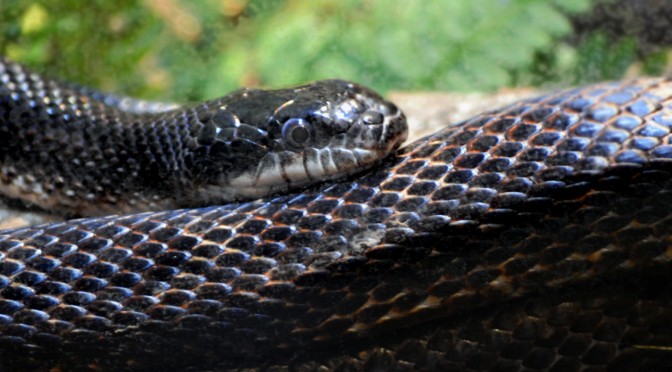NOTE: Education Animals are “behind-the-scenes” animals & only appear to the public during Educational events. This includes scheduled events or programs such as daily animal mingles, private onsite programs, and zoo reaches. For more information, please reach out to edureservations@lvzoo.org.
Program and General Information
Angolan pythons are a non-venomous, constrictor species native to the shrublands and rocky outcrops of Southern Angola to Namibia. They are a moderately sized snake ranging from 3-6 feet in length. These pythons are a reddish-brown to brown (almost black), overlaid with irregular white or cream bands and spots. Their belly is yellowish and their head is covered by a large, reddish-brown triangular marking bordered on the sides by creamy white, black- edged bands. Angolan pythons are carnivores and their diet consists of small mammals, birds, amphibians and insects. Not much is known about this snake, but October is thought to be peak breeding season. Angolan pythons are oviparous and lay small clutches of 4-5 eggs, which hatch after about 70 days.
Diet
Angolan pythons are carnivores. Their diet primarily consists of small mammals and birds, but will also prey on small amphibians and occasionally insects.
They are largely nocturnal preferring to hunt for their food at night. Angolan pythons have five heat sensitive pits on either side of their face allowing them to figure out the distance and direction of warm-blooded prey.
Habitat and Range
Angolan pythons are found in Southwest Africa from Southern Angola to Namibia. These snakes live in the scrublands, grasslands, and rocky areas limited to elevations between 2460 and 5250 feet above sea level.
Little is known about the python’s natural history in the wild due primarily to its isolation within its range, some of which has experienced war and political unrest. From what field observations have been done, Angolan pythons appear to prefer rocky outcrops and drier habitats. Precipitation is rare and populations will concentrate around whatever source of water they can find.
Angolan pythons can withstand extreme temperatures as high as 122 degrees Fahrenheit and as low as 32 degrees Fahrenheit. Because they live in such harsh environments, these snakes will often seek shelter in caves and rocky outcroppings. Bead-like scales help Angolan pythons retain moisture in their dry environments.
Common Physical Features
Since these snakes live in such a harsh environment and the political unrest and wars surrounding their native habitats make it difficult for researchers to reach them, little information is known about these snakes. The info that we do know is from what few field observations have been made throughout the years. Angolan pythons are a moderately sized snake that can grow up to 3-6 feet. Pythons and Boas, including Angolan pythons, have anal spurs, appearing on each side of the vent. These spurs are important for the mating process, aiding the snakes in clasping onto their mate. The spurs on males are generally longer than those on females.
Angolan python’s coloration form a type of camouflage called countershading where the upper side is dark in color and the underside is light in color.
Adaptations: Being primarily nocturnal hunters, Angolan pythons have adapted to hunt better at night. Above their lip they have heat-seeking pits, which are able to detect wavelengths of light in the infrared spectrum and the signal is processed visually, meaning, they are capable of seeing a thermal image of their surroundings giving them an advantage in hunting in the dark as well as seeking out refuges when temperatures are too hot or cold.
Snakes have an interesting way of sniffing out their prey items. Like other reptile species, Angolan pythons have a Jacobson’s organ in the roof of their mouth. They will stick out their tongue in order to pick up scent particles in the air or from the surface of objects.
Their tongues are forked at the end, splitting in two directions in a V-shape, allowing the snake to pick up scent particles from two different directions. When the tongue is brought into the mouth to the Jacobson’s organ, the organ will process the information and determine which side of the tongue the scents came from. This will inform the snake which direction to go to find that scent. (If it picks up the scent on the left fork, then it knows to go to the left. If it picks it up on the right, then it goes to the right. And then if it picks up the scent on both forks then it knows the scent is coming from straight ahead. )
Angolan pythons are ambush predators; they will sit and wait for their prey to come to them. Like other snakes, they do not have moveable eyelids. Instead, they have a special clear scale that covers the eyes, making them appear to be always awake. Not having eyelids allows the Angolan python to refrain from blinking and keep its cover when it is camouflaged. Once a prey is close enough, the Angolan python will grab the prey and wrap tightly around it.
They have powerful body muscles to squeeze and suffocate prey. Snakes have a highly flexible skull that allows them to swallow their prey whole. Contrary to popular belief, they do not actually unhinge/dislocate their jaws to swallow prey because there isn’t anything to actually unhinge/dislocate! A snake’s jaw is only loosely joined to its skull by ligaments, which allows the jaw to be solid enough to bite, but flexible enough to expand for swallowing. Once prey is inside the mouth, the snake alternate using the left and right sides of the upper and lower jaws to “walk” the prey to the back of the throat where powerful muscles will help force the prey down the rest of the body. To better visualize the movement of the jaw imagine laying on your stomach and crawling using your elbows and knees to move. That is similar to how the snake’s upper and lower jaws work to push the food into the mouth and down the throat.
Behavior and Life Cycle
Angolan pythons are oviparous, laying small clutches of 4-5 eggs. It is not known whether or not the females incubate the eggs as other pythons do. The eggs hatch after about 70 days, and hatchlings are between 10-17 inches long.
Hatchlings are independent from birth and mature around 3 years of age.
Conservation Messaging
Purposeful Pet Ownership
Although a decent sized snake, Angolan pythons are considered fairly docile. This has made them quite popular in the pet trade. Many people don’t realize, however, just how much work goes into caring for reptile species. Reptiles require specific lighting, humidity, space, nutrients, substrate, heating, and if they do not receive the proper care then that reptile’s health can decline rapidly. It can be difficult to find veterinarians that are equipped to care for reptiles if they get sick.
By purchasing and owning an exotic animal, you could be supporting the illegal exotic pet trade. Oftentimes these exotic pets are taken out of their natural habitat to be sold in the pet trade, which can be detrimental to wild populations. One more exotic pet in captivity is one less animal in the wild which is resulting in species population numbers dropping drastically. This is especially harmful for species like the Angolan python whose populations are already hard to get to and study because researchers may not be able to catch a decline in numbers as easily or quickly.
What can we do?: Be sure to fully research any pet before buying one. While you may think a reptile would make a cool pet, it’s important to know all of the care that goes into providing that animal with the best possible welfare, and as mentioned before reptiles require a lot of extra care. It is important to make sure that if you do buy an exotic pet that you are buying it from a reputable breeder, someone who knows how to properly care for the animal and hasn’t taken that animal from its natural habitat.
Do not release an unwanted pet into the wild. While you may think that you are doing something good by releasing the animal back into the wild, animals that have been kept under human care often do not know how to survive on their own out in the wild and could end up getting hurt or dying if left to their own devices.
Fun Facts
- Angolan pythons are one of the rarest snake species in Africa. They are also known as Anchieta’s Dwarf Pythons.
- Ecological Role of Reptiles: Snakes play an important role as both prey and predator in ecosystems all over the world. They can be very important in regulating the populations of pest species such as rodents which are common around human activity.
- Angolan pythons are the national snake of Namibia.
Bibliography











